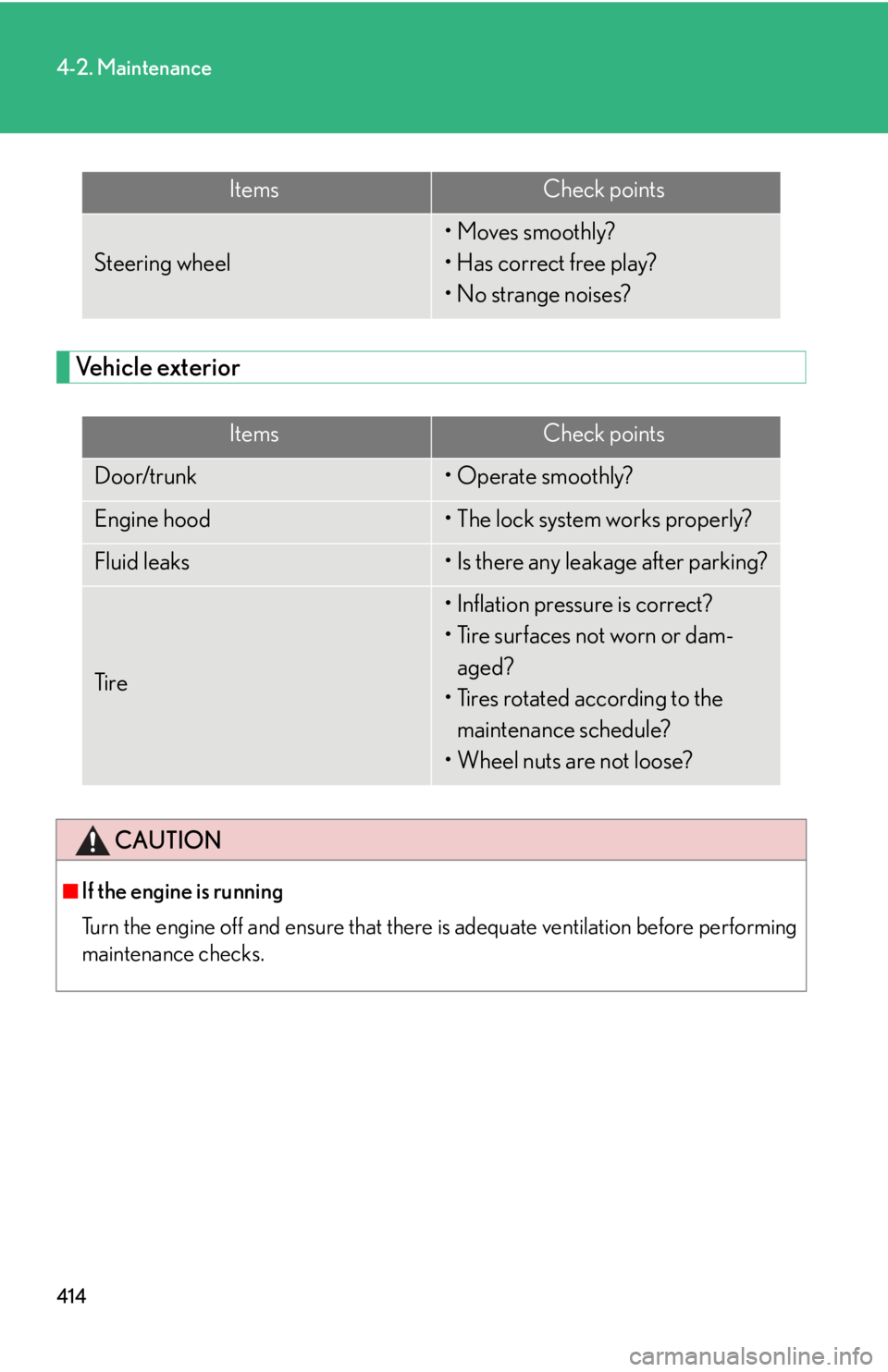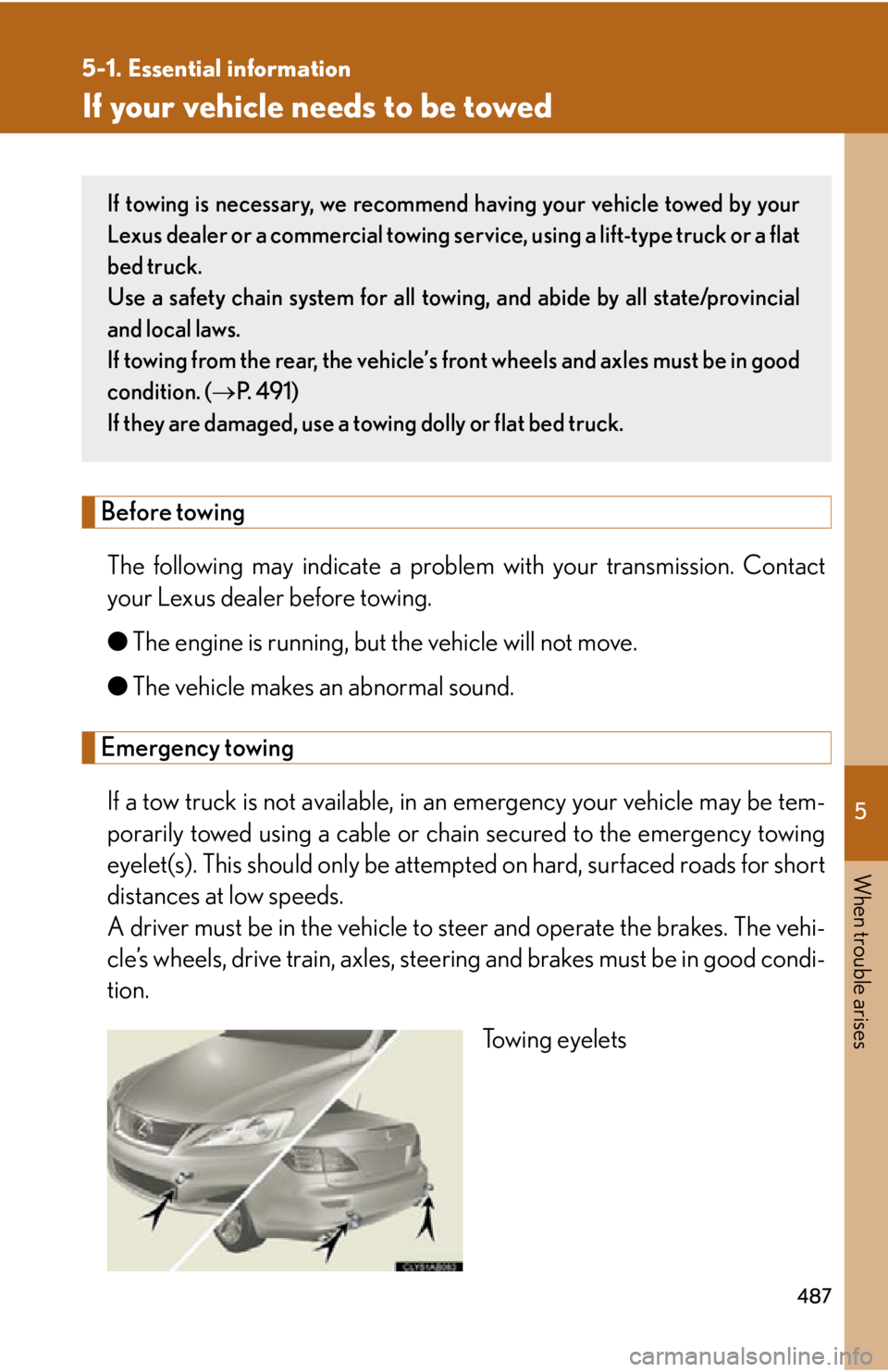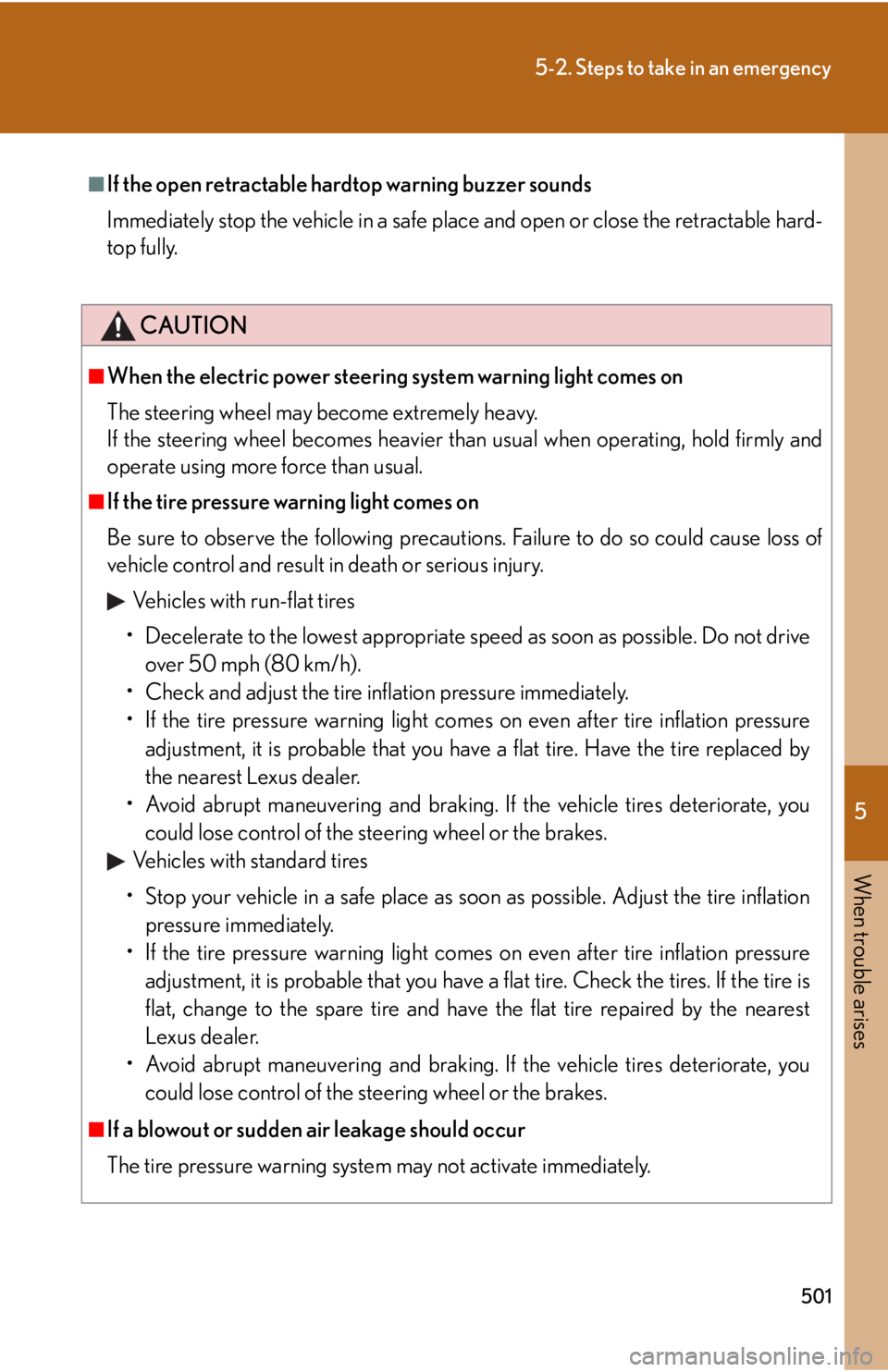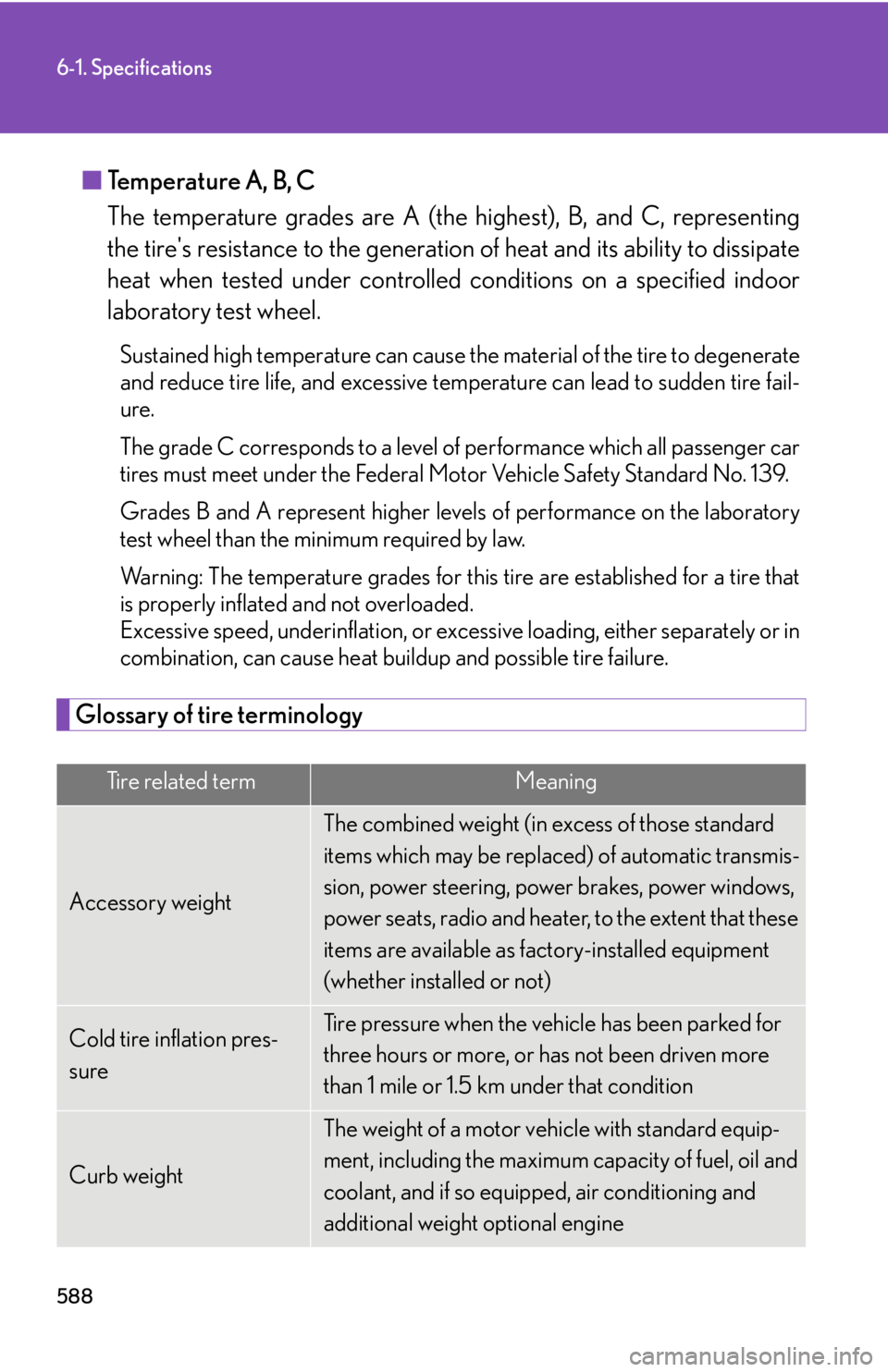steering wheel Lexus IS250C 2012 Instrument cluster / LEXUS 2012 IS250C,IS350C (OM53A62U) Workshop Manual
[x] Cancel search | Manufacturer: LEXUS, Model Year: 2012, Model line: IS250C, Model: Lexus IS250C 2012Pages: 632, PDF Size: 6.77 MB
Page 414 of 632

414
4-2. Maintenance
Vehicle exterior
Steering wheel
• Moves smoothly?
• Has correct free play?
• No strange noises?
ItemsCheck points
Door/trunk• Operate smoothly?
Engine hood• The lock system works properly?
Fluid leaks• Is there any leakage after parking?
Ti r e
• Inflation pressure is correct?
• Tire surfaces not worn or dam-aged?
• Tires rotated according to the maintenance schedule?
• Wheel nuts are not loose?
CAUTION
■If the engine is running
Turn the engine off and ensure that there is adequate ventilation before performing
maintenance checks.
ItemsCheck points
Page 487 of 632

5
When trouble arises
487
5-1. Essential information
If your vehicle needs to be towed
Before towingThe following may indicate a problem with your transmission. Contact
your Lexus dealer before towing.
● The engine is running, but the vehicle will not move.
● The vehicle makes an abnormal sound.
Emergency towing
If a tow truck is not available, in an emergency your vehicle may be tem-
porarily towed using a cable or chain secured to the emergency towing
eyelet(s). This should only be attempted on hard, surfaced roads for short
distances at low speeds.
A driver must be in the vehicle to s teer and operate the brakes. The vehi-
cle’s wheels, drive train, axles, steering and brakes must be in good condi-
tion.
Towing eyelets
If towing is necessary, we recommend having your vehicle towed by your
Lexus dealer or a commercial towing se rvice, using a lift-type truck or a flat
bed truck.
Use a safety chain system for all towi ng, and abide by all state/provincial
and local laws.
If towing from the rear, the vehicle’s front wheels and axles must be in good
condition. ( P. 4 9 1 )
If they are damaged, use a to wing dolly or flat bed truck.
Page 488 of 632

488
5-1. Essential information
■Emergency towing procedureRelease the parking brake.
Shift the shift lever to N.
Put the “ENGINE START STOP” switch in ACCESSORY mode or IGNI-
TION ON mode.
CAUTION
■Caution while towing
●Use extreme caution when towing the vehicle.
Avoid sudden starts or erratic driving maneuvers which place excessive stress on
the emergency towing eyelets and the cables or chains. Always be cautious of the
surroundings and other vehicles while towing.
●If the engine is not running, the power assi st for the brakes and steering will not
function, making steering and braking more difficult.
NOTICE
■To prevent causing serious damage to the transmission
(vehicles with an automatic transmission)
Never tow this vehicle from the front with the rear wheels on the ground.
This may cause serious dama ge to the transmission.
■When towing a vehicle without using a towing dolly
(vehicles with a manual transmission)
The “ENGINE START STOP” switch must not be OFF.
STEP1
STEP2
STEP3
Page 491 of 632

5
When trouble arises
491
5-1. Essential information
Towing with a wheel lift-type truckFrom the front Vehicles with an automatic trans-
mission: Use a towing dolly under
the rear wheels.
Vehicles with a manual transmis-
sions: We recommend to use a
towing dolly under the rear wheels.
When not using a towing dolly,
release the parking brake and shift
the shift lever to N.
From the rearSwitch to ACCESSORY mode so
that the steering wheel is
unlocked.
Page 492 of 632

492
5-1. Essential information
Using a flat bed truckIf your Lexus is transported by a
flat bed truck, it should be tied
down at the locations shown in the
illustration.
If you use chains or cables to tie
down your vehicle, the angles
shaded in black must be 45 .
Do not overly tighten the tie downs
or the vehicle may be damaged.
NOTICE
■To prevent causing serious damage to the transmission
(vehicles with an automatic transmission)
Never tow this vehicle from the front with the rear wheels on the ground.
■To prevent damaging the vehicle
●Do not tow the vehicle from the rear with the “ENGINE START STOP” switch
OFF.
The steering lock mechanism is not st rong enough to hold the front wheel
straight.
●When raising the vehicle from the rear, ensure adequate ground clearance for
towing at the opposite end of the raised vehicle. Without adequate clearance, the
vehicle could be damaged while being towed from the rear.
Page 501 of 632

5
When trouble arises
501
5-2. Steps to take in an emergency
■If the open retractable hardtop warning buzzer sounds
Immediately stop the vehicle in a safe place and open or close the retractable hard-
top fully.
CAUTION
■When the electric power steering system warning light comes on
The steering wheel may become extremely heavy.
If the steering wheel becomes heavier than usual when operating, hold firmly and
operate using more force than usual.
■If the tire pressure warning light comes on
Be sure to observe the following precautions. Failure to do so could cause loss of
vehicle control and result in death or serious injury.
Vehicles with run-flat tires
• Decelerate to the lowest appropriate speed as soon as possible. Do not drive over 50 mph (80 km/h).
• Check and adjust the tire inflation pressure immediately.
• If the tire pressure warning light comes on even after tire inflation pressure
adjustment, it is probable that you have a flat tire. Have the tire replaced by
the nearest Lexus dealer.
• Avoid abrupt maneuvering and braking. If the vehicle tires deteriorate, you
could lose control of the steering wheel or the brakes.
Vehicles with standard tires
• Stop your vehicle in a safe place as soon as possible. Adjust the tire inflation pressure immediately.
• If the tire pressure warning light comes on even after tire inflation pressure adjustment, it is probable that you have a flat tire. Check the tires. If the tire is
flat, change to the spare tire and have the flat tire repaired by the nearest
Lexus dealer.
• Avoid abrupt maneuvering and braking. If the vehicle tires deteriorate, you
could lose control of the steering wheel or the brakes.
■If a blowout or sudden air leakage should occur
The tire pressure warning system may not activate immediately.
Page 516 of 632

516
5-2. Steps to take in an emergency
Once
(Vehicles with an auto-matic transmission)
Indicates that a
door has been
opened or closed
and the “ENGINE
START STOP”
switch has been
switched twice to
ACCESSORY
mode from OFF.
Press the
“ENGINE START
STOP” switch
while applying the
brakes.
Once
(Vehicles with a manual transmission)
Indicates that a
door has been
opened or closed
and the “ENGINE
START STOP”
switch has been
switched twice to
ACCESSORY
mode from OFF.
Press the
“ENGINE START
STOP” switch
while depressing
the clutch pedal.
(Flashing)
Indicates that the
steering lock has
not released
within 3 seconds
of pressing the
“ENGINE START
STOP” switch.Press the
“ENGINE START
STOP” switch
again while turn-
ing the steering
wheel with the
brake pedal
depressed.
InteriorbuzzerExterior buzzerMessageDetailsCorrection
procedure
Page 557 of 632

5
When trouble arises
557
5-2. Steps to take in an emergency
If your vehicle has to be stopped in an emergency
CAUTION
■If the engine has to be turned off while driving
Power assist for the brakes and steering wheel will be lost, making the brake pedal
harder to depress and the steering wheel heavier to turn. Decelerate as much as
possible before turning off the engine.
Only in an emergency, such as if it becomes impossible to stop the vehicle
in the normal way, stop the vehicle using the following procedure:
Steadily step on the brake pe dal with both feet and firmly
depress it.
Do not pump the brake pedal repeatedly as this will increase the
effort required to slow the vehicle.
Shift the shift lever to N.
If the shift lever is shifted to N After slowing down, stop the vehicl e in a safe place by the road.
Stop the engine.
If the shift lever cannot be shifted to N Keep depressing the brake pedal with both feet to reduce vehi-
cle speed as much as possible.
Stop the engine by pressing and
holding the “ENGINE START
STOP” switch for 3 consecutive
seconds or more.
Stop the vehicle in a safe place by the road.
STEP1
STEP2
STEP3
STEP4
STEP3
Press and hold for 3 seconds or more
STEP4
STEP5
Page 572 of 632

572
6-1. Specifications
Steering
Tires and wheelsTy p e A
Free playLess than 1.2 in. (30 mm)
Ti r e s i z e
Front tires: 225/45R17 90W
Rear tires: 245/45R17 95W
Spare tire: T125/70D17 98M
Front and rear tire inflation pres-
sure
(Recommended cold tire inflation
pressure)
Driving under normal conditions
Front:
35 psi (240 kPa, 2.4 kgf/cm
2 or bar)*
Rear:
38 psi (260 kPa, 2.6 kgf/cm
2 or bar)*
Spare:
60 psi (420 kPa, 4.2 kgf/cm
2 or bar)
*: When driving at high speeds above 100 mph (160 km/h), in countries where such speeds
are permitted by law, add 4.5 psi (30 kPa, 0.3
kgf/cm
2 or bar) to the front tires and rear
tires. Never exceed the maximum cold tire
inflation pressure indicated on the tire side-
wall.
Wheel size17 8J, 17 4T (spare)
Wheel nut torque76 ft•lbf (103 N•m, 10.5 kgf•m)
Page 588 of 632

588
6-1. Specifications
■Temperature A, B, C
The temperature grades are A (the highest), B, and C, representing
the tire's resistance to the generation of heat and its ability to dissipate
heat when tested under controlled conditions on a specified indoor
laboratory test wheel.
Sustained high temperature can cause the material of the tire to degenerate
and reduce tire life, and excessive temperature can lead to sudden tire fail-
ure.
The grade C corresponds to a level of performance which all passenger car
tires must meet under the Federal Mo tor Vehicle Safety Standard No. 139.
Grades B and A represent higher levels of performance on the laboratory
test wheel than the minimum required by law.
Warning: The temperature grades for this tire are established for a tire that
is properly inflated and not overloaded.
Excessive speed, underinflation, or excess ive loading, either separately or in
combination, can cause heat buildup and possible tire failure.
Glossary of tire terminology
Tire related termMeaning
Accessory weight
The combined weight (in excess of those standard
items which may be replaced) of automatic transmis-
sion, power steering, power brakes, power windows,
power seats, radio and heater, to the extent that these
items are available as factory-installed equipment
(whether installed or not)
Cold tire inflation pres-
sureTire pressure when the vehicle has been parked for
three hours or more, or has not been driven more
than 1 mile or 1.5 km under that condition
Curb weight
The weight of a motor vehicle with standard equip-
ment, including the maximum capacity of fuel, oil and
coolant, and if so equipp ed, air conditioning and
additional weight optional engine